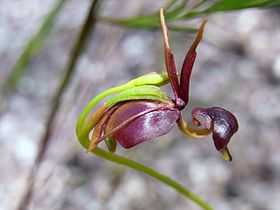Caleana major
| Flying Duck Orchid | |
|---|---|
 | |
| Ku-ring-gai Chase National Park, Australia | |
| Scientific classification | |
| Kingdom: | Plantae |
| (unranked): | Angiosperms |
| (unranked): | Monocots |
| Order: | Asparagales |
| Family: | Orchidaceae |
| Subfamily: | Orchidoideae |
| Tribe: | Diurideae |
| Subtribe: | incertae sedis |
| Genus: | Caleana |
| Species: | C. major |
| Binomial name | |
| Caleana major R.Br. | |
| Synonyms | |
|
| |
Caleana major, the Flying Duck Orchid, is a small orchid found in eastern and southern Australia.[1] This terrestrial plant features a remarkable flower, resembling a duck in flight. The flower is an attractant to insects, such as male sawflies which pollinate the flower in a process known as pseudocopulation.[1] In 1986 this orchid was featured on an Australian postage stamp.[2]
Description
Caleana major is encountered as a terrestrial herb, up to 50 cm (20 in) tall. 2-4 flowers grow on the green stem.[3] The single leaf, appears near the base of the stalk. It is usually prostrate, narrow-lanceolate, to 12 cm (5 in) long and 8 mm wide, often spotted.[4] The flower is reddish-brown, 15 to 20 mm long. In rare cases, the flower can be greenish with dark spots.[4] The plant is pollinated by insects. A sensitive strap is attached to the flower, which is triggered by vibration. Flowering occurs from September to January.[5]
Distribution and habitat
Occurring from Queensland to South Australia, to even Tasmania,[6][7] this plant is found in eucalyptus woodland in coastal or swampy shrubland and heathland. Mostly near the coast, but occasionally at higher altitudes.[4] Because of the small size, it is a difficult plant to notice in the wild.
Taxonomy
The genus Caleana was named after George Caley, an early botanical collector.[6] Latin for "larger", major refers to the contrast with the other smaller Duck orchid, Paracaleana minor.
The original specimen of this plant was collected at Bennelong Point, the present day site of the Sydney Opera House in September, 1803.[8] In 1810, the species originally appeared in the scientific literature, Prodromus Florae Novae Hollandiae, authored by the prolific Scottish botanist, Robert Brown.
Cultivation
Caleana major has been difficult to maintain in cultivation. Plants flower for one or sometimes two years but progressively weaken until they die.[6]
-
.jpg)
illustration by Ferdinand Bauer
-
closed Flying Duck orchid
-

new Duck flower in September
-

Flying Duck Orchid
References
- ↑ 1.0 1.1 Les Robinson - Field Guide to the Native Plants of Sydney, ISBN 978-0-7318-1211-0 page 241
- ↑ http://www.anbg.gov.au/stamps/stamp.991.html
- ↑ http://www.friendsoflanecovenationalpark.org.au/Flowering/Flowers/Caleana_major.htm
- ↑ 4.0 4.1 4.2 "Caleana major". PlantNET - NSW Flora Online retrieved October 30th, 2010.
- ↑ Fairley, Alan; Moore, Philip (2010). Native Plants of the Sydney Region: An Identification Guide (3rd ed.). Crows Nest, NSW: Jacana Books (Allen & Unwin). p. 563. ISBN 978-1-74175-571-8.
- ↑ 6.0 6.1 6.2 Elliot, Rodger W.; Jones, David L.; Blake, Trevor (1985). Encyclopaedia of Australian Plants Suitable for Cultivation: Vol. 2. Port Melbourne: Lothian Press. p. 408. ISBN 0-85091-143-5.
- ↑ "Australian Orchids in New Zealand, National Library of New Zealand".
- ↑
- "Caleana major R.Br.". Australian Plant Name Index (APNI), IBIS database. Centre for Plant Biodiversity Research, Australian Government.
